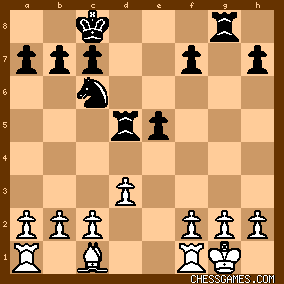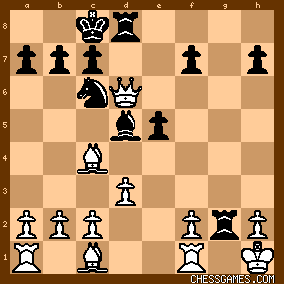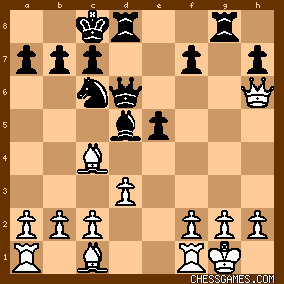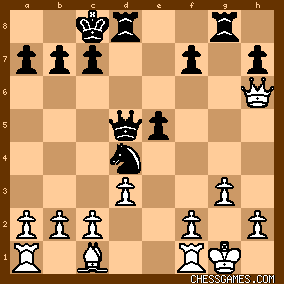|
< Earlier Kibitzing · PAGE 2 OF 2 ·
Later Kibitzing> |
Dec-02-14
 | | Bubo bubo: White has mistakenly assumed that he can afford to trade queens before taking care of the hot spot g2, but Black easily debunks this claim with 13...Rxg2+ 14.Kh1 Rg1++ 15.Kxg1 Rg8+ and mate next move. |
|
| Dec-02-14 | | whiteshark: D'oh, I felt into the trap mentioned by <lost in space: <Other rook moves like 14..Rxf2+ loses due to 15. Qxd5>> :((not my day) |
|
| Dec-02-14 | | mcguigan97: <whiteshark: D'oh, I felt into the trap mentioned by <lost in space: <Other rook moves like 14..Rxf2+ loses due to 15. Qxd5>> :((not my day)> Me too :( |
|
| Dec-02-14 | | wooden nickel: It's comforting to see that even strong players sometimes overlook a simple threat!
White must have had in mind: 13. ... Rxd6 14. Bxd5 Rxd5

click for larger view
and was dreaming of a nice ending! |
|
| Dec-02-14 | | morfishine: <Once> You are right to suspect that something
doesn't make sense with White's move order. Capturing the
g-pawn AND leaving Black's WSB on <d5> just doesn't make
sense
The only thing I can figure is White, well, just forgot to capture
the Bishop
This reminds me of an old Alekhine story where he found
himself dead lost two pawns down and short of time. Staring glumily at the
board, a diabolical idea began to form: Deflect the Black Queen
(sacrificing another pawn) then sacrifice a whole rook. White
then gets a perpetual check, salvaging a draw. Alekhine relates
how he ran through the calculations once more, using up most
of his remaining time, and satisfied it was all forced, proceeded
to sacrifice the rook before first making the simple pawn move! Black won easily. Alekhine commented it was a bitter but valuable
lesson. He had become so emersed in final calculations, he forgot the
first move of the combination!
***** |
|
| Dec-02-14 | | Chess Dad: Only because it's a puzzle. OTB I don't think I'd have seen this. 14... Rxg2+ 15. Kh1 Rg1++ 16. Kxg1 Rg8+ 17. Qg6 Rxg6# |
|
| Dec-02-14 | | Chess Dad: Whoops. Looking over another's solution, it seems I have to modify. 17... Rxg6+ 18. Bg5 Rxg5#. Darn it. I got the right idea, and the right attack, I missed the one move delay with the Bishop. |
|
| Dec-02-14 | | gars: I thought about
13) ... Rxg2+
14) Kh1 Rxf2+
15) Kg1 R(d8)g8+ etc. |
|
| Dec-02-14 | | TheaN: Tuesday 2 December 2014 <13....?> Black is down a queen and a pawn, yet the former can be immediately recaptured in the position at hand. When initially seeing this position I thought white dared to capture on g7 with the queen and such gave black a very dangerous control over the g-file, now g2 in particular. White thought he had adequately control over the situation by attacking Bd5 with both his queen and bishop, as after 13....Rxg2+ 14.Kh1 Rxd6? loses due to 15.Bxd5, grabbing the deadly bishop putting the g2-rook en prise. In the position at hand, playing 'remove g2' would mate white. Alas, this is not possible just by saying this: black has to play <13....Rxg2+ 14.Kh1> first to accomplish this. Now, the rook is in the way of the bishop. Removing the rook leads to a bishop check, so white can capture on d5, winning. If black checks with both pieces it is a different story. After <14....Rg1++ 15.Kg1> the g-pawn is in fact gone, and black can reload with the other rook. After <15....Rg8+>, <16.Qg6 Rxg6+ 17.Bg5 Rxg5# 0-1>. The key is that two checks are with the rook, and one is double. The bishop is never on his own. This is what white missed, and black did not. |
|
Dec-02-14
 | | Penguincw: Oh shoot. I didn't realize the bishop was attacked, so played 13...Rxg2+ 14.Kh1 Rg3+, thinking it was checkmate. :o |
|
Dec-02-14
 | | Sally Simpson: Possibly a classic case were a weaker player would not have got mated from this position because he was not as well read as the player of the White bits was in this game. A weaker player would have stopped Rxg2+ without considering any other move. Here The stronger player saw....

click for larger view....that the Pillsbury Shuffle is not on.

click for larger viewThe Pillsbury Shuffle.
1...Rxf2+ 2.Kg1 Rg2+ 3.Kh1 Rg8+ mate next move.
This is tharted in the game by Qxd5. End of analysis.
So he went for clipping the Queens missing completely the 15...Rg1+ 16.Kxg1 Rg8+ pattern. Too much knowledge can be a dangerous thing.
What about our fictitious weaker player?
Here....

click for larger viewHe would played 13.Bxd5 Qxd5 and probably 14.g3.

click for larger viewBackward Queen defensive moves like 14.Qh3+ are not yet in his vocab, position weakening pawn moves are. And after 14.g3 he would be looking at a very miserable position after Black plays 14...Nd4. 
click for larger view |
|
| Dec-02-14 | | starry2013: I saw the possiblity of Rg8 and the initial sacrifice of Rg2 and the use of the bishop too, but I missed Rg1. |
|
| Dec-02-14 | | Besrqe: I agree that White needs to trade off the Black QB on move 11 or 12 and the pawn on g7 can safely be taken. The easiest line is 11.Bxd5 Qxd5 12.Qxg7 0-0-0 13. Qg4+! getting out of dodge with tempo. Then, White can consolidate by centralizing the Q with Qe4 or Qc4 and finish development with Be3. And white's just a pawn up with a healthy pawn structure and just needs to keep trading. |
|
| Dec-02-14 | | kevin86: Black forces a mate with a surprise double check at g1. The second rook will deliver mate along the open g file. |
|
| Dec-02-14 | | alphee: I like this one, including the 'The Pillsbury Shuffle' that's completely new to me. Searching a bit I got it on the web, with a slightly different name, at
http://www.chess.com/article/view/m....
I surely need to do more 'home work'. |
|
| Dec-02-14 | | Calar: <Once> I'd never play Qxg7 in a game. Silicon brains may find optimal moves, defend accurately and keep an extra pawn, but for humans such move is tightrope walking where every misstep can be punished by mating attack. One pawn is not worthy in this kind of position, where player of my strength would sooner or later stumble and lose a game. |
|
Dec-02-14
 | | Sally Simpson: Hi alphee,
I introduced the term Pillsbury Shuffle and Pillsbury Two-Step because I thought it easier to recall. It sticks. I did an article on this ages ago showing players of our ilk pulling these tricks off. http://www.redhotpawn.com/blog/blog... (It's been a while since I saw that page. It has 10,000+ hits! I write this nonsense really to keep myself amused - who is reading it?) |
|
| Dec-02-14 | | laskereshevsky: Rxg2+ Kh1 Rg1+ Kxg1 Rg8 and mate to follow |
|
| Dec-02-14 | | Longview: <Penguincw>I did not see the white bishop attack either and thought that the g2 R could just withdraw for #.
<morfishine> your story of Alekhine is helpful, having done that more than once on a think, I move the critical move but not the first one in the critical order. Very much like a poor golfer attempting a shot not often played, say from the sand, anxious he stands over the shot considering his actions then swings quickly forgetting the key is to move his weight to his forward side, thus he misses the shot entirely and remains in the bunker penalized again. Totally unexpected move order for todays game, for me, anyway. |
|
Dec-02-14
 | | PawnSac: A simple but clever idea with aesthetic appeal...
Rxg2+ Kh1 Rg1+ Kxg1 Rg8 with unavoidable mate.
It only took a few seconds to see it, but this in no way diminishes its chessic satisfaction. These are the kinds of positions with which to nurture young minds. |
|
| Dec-02-14 | | morfishine: <Longview> I like your reference to golf: I took my swipes on the local tour(s) a couple of times and know exactly what you are talking about :) ***** |
|
| Dec-02-14 | | TheBish: I Saric vs I Papadatos, 1994 Black to play (13...?) "Easy"
I suppose White expected Black to recapture the queen, leaving White up a pawn. He must have been surprised by how quickly things ended, if Black did find the forced mate! It's mate in 5: 13...Rxg2+! 14. Kh1 Rg1+! (if not for this move, Black would be losing at this point) 15. Kxg1 Rg8+ 16. Qg6 (computer move; most humans would resign before playing this) Rxg6 + 17. Bg5 Rxg5#. |
|
| Dec-02-14 | | TheBish: Hard to believe a master missed this, and allowed it to happen. Early in the game, so most likely not due to time pressure. |
|
| Dec-03-14 | | patzer2: <Sally Simpson> Thanks for the analysis and for sharing the link to your article at http://www.redhotpawn.com/blog/blog... explaining "Pillsbury's mate" and coining the phrases "Pillsbury shuffle" and "Pillsbury Two Step" for two variations of it. As you observe, after 13. Qxd6?? White falls into the "Pillsbury Two Step" with 13...Rxg2+! 14. Kh1 Rg1+! 15. Kxg1 Rg8+ 16. Qg6 Rxg6 + 17. Bg5 Rxg5# solving today's Tuesday puzzle. Had he seen it coming, White could have avoided the mate on his 11th, 12th or 13th moves by capturing the Bishop on d5 (i.e. 11. Bxd5, 12. Bxd5 or 13. Bxd5): 11. Bxd5 Qxd5 12. Bd2 =.
12. Bxd5 Qxd5 13. Qg4+ Kb8, when play might continue 14. Be3 Rhg8 15. Qe4 Qd7 16. f4 f5 17. Qc4 Qg7 18. Rf2 exf4 19. Bxf4 Qxb2 20. Re1 Qb6 21. Kf1 h5 22. Rfe2  . . 13. Bxd5! Qxd5 when play might continue 14. f3 Nd4 15. Qh3+! Kb8 16. Rf2 h6 17. Be3 Rg6 18. Qh5 Qe6 19. a4 Nf5 20. Re1 Nxe3 21. Rxe3 Rg5 22. Qh4!  . . |
|
| Dec-03-14 | | patzer2: <Once> <OTB I wouldn't play 11. Qxg7, but maybe I am worrying about the ghost of an attack that isn't really there. What do others think?>
It's a matter of taste. Some like the adventure of accepting gambits and finding their way through a maze of complications to equalize or find an advantage. Others like to decline early and go for equality and then seek an advantage in lines their opponent hasn't prepared for. The prudent course in this game might have been 11. Bxd5 Qxd5 12. Bd2 = avoiding complications. But what fun is there in that?
I like White's idea of 11. Qxg7!, but with 12. Bxd5! or 13. Bxd5! instead of 13. Qxd6?? |
|
 |
|
< Earlier Kibitzing · PAGE 2 OF 2 ·
Later Kibitzing> |





